When traders think about cryptocurrencies, they focus more on how they can profit from the price swings. But, what happens when you’ve purchased a certain digital asset at a low price, but it refuses to rise? You keep them in your cryptocurrency wallet and wait. This is why crypto wallets are important, especially the hardware wallets.
In This Article:
What are Cryptocurrency Wallets?
A cryptocurrency wallet is a program used for storing, sending, and receiving cryptocurrencies. Cryptocurrency wallets typically contain your public address and private keys. Traditional wallets help users to store cash physically. With cryptocurrency wallets, however, things are a bit different thanks to the blockchain technology.
It’s worth noting that cryptocurrencies aren’t stored in wallets, it’s their private keys that are recorded there. Since cryptocurrencies have no physical form, they’re stored digitally on a blockchain.
Wallet Addresses, Public and Private Keys
To fully understand how a cryptocurrency wallet works, it’s important to be familiar with wallet addresses, public keys, and private keys. The address works the same way as your account number does. You can give out your account number to someone, especially if they’re planning to send you some money- whether it’s your employer, a friend or family member, a customer, etc. The same applies to your wallet address.
Wallets use a combination of letters (uppercase and lowercase) and numbers.
Another important concept that concerns crypto wallets and how they operate are the keys that control funds. Every wallet comes with both public and private keys.
The private key allows the crypto holder to access the funds in the wallet. It works the same way as the password on your online bank account. In the traditional banking system, your password is known to you alone. The bank might have access to your account number, but they can’t access your password.
When you want to send funds online, you log-in to your bank platform and use your password to initiate transactions. A private key does the same thing. It is linked to a specific wallet address, and is used to gain access to the funds and ensure security.
The public key, on the flip side, is a hashed tool mathematically linked to the wallet address. The hash function here allows for a sequence of numbers and/or letters (in this case, called an input) to be encrypted into a new set of numbers and/or letters (known as the output). The hashed version of a public key is the wallet address used to publicly receive Bitcoins.
The Broad Categorization of Wallets
Generally, cryptocurrency wallets can be categorized into hot, and cold wallets.
1. Hot Wallets
Hot wallets are wallets connected to the Internet. Most cryptocurrency exchanges use them due to their ability to fast-track transactions. The only problem with hot wallets is that they are much more susceptible to hacks because they’re connected to the internet.
2. Cold Wallets
Cold storage wallets are wallets used to store digital assets offline. Examples of cold wallets are hardware wallets and paper wallets. Cryptocurrency exchanges use cold wallet solutions as a security measure to keep customer’s funds safe. Due to their structure, they are less susceptible to hacks. In this guide, we’ll be focusing on hardware wallets.
Hardware Wallets
Hardware wallets use a physical device or smartcard to store the user’s private keys and act as more of a physical cryptocurrency wallet. They are beneficial for long term hodlers due to its immunity to computer viruses. To use a hardware wallet, the user has to connect to the manufacturer’s web interface to initiate or verify transactions sent to their public keys.
How Hardware Wallets Work
As we’ve cleared up, your cryptocurrencies are stored on the blockchain. The hardware wallet simply stores the private key. So, since the blockchain is ubiquitous, you need a wallet to store them, and you need the private keys to access them. The private keys are stored on the wallet and are protected by a special PIN and a passphrase (optional).
Should you lose your hardware wallet, your assets are backed up by a seed phrase. Since you alone know the phrase, you can easily use it to move your private key from one hardware wallet to another.
The Best Hardware Wallets for Storing Cryptocurrencies
1. Ledger Nano S
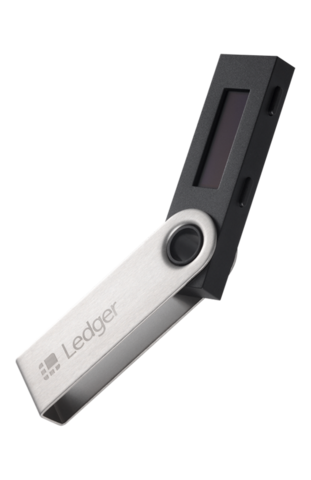
Ledger is a French blockchain firm and one of the most credible manufacturers of hardware wallets in the crypto space. The company has been around since 2014, and has made over a million hardware wallet sales in over 160 countries. Besides its wallets, the firm has also rolled out products like Ledger Vault for institutions that want to invest and store their cryptocurrencies securely.
The Nano S is a USB drive that works based on a smart card. It measures 39 x 13 x 4mm (1.53 x 0.51 x 0.16in), and only 5.9g in weight. The Ledger Nano S supports 1,184 coins currently, including all of the most popular ones.
To activate the wallet, you connect it to a computer via its USB cable. When you create a new wallet, you confirm your PIN, which you’ll need to use whenever you access the wallet.
Supported Coins:
Ledger supports a large variety of assets, including:
- Bitcoin
- Ethereum
- Ripple
- Tether
- Bitcoin Cash
- Litecoin
- And many more…
Ledger Nano S Price: $55
Pros
- The wallet features secure-ship technology
- It has a simple setup process
- Its supported coins are quite extensive
- It integrates with several wallets
- It’s capable of running on third-party apps
- The recovery process can be carried out without connecting to a computer
- It’s lightweight, so carrying it is easy
Cons
- The software isn’t open-source
- It doesn’t have Bluetooth capabilities
2. Ledger Nano X
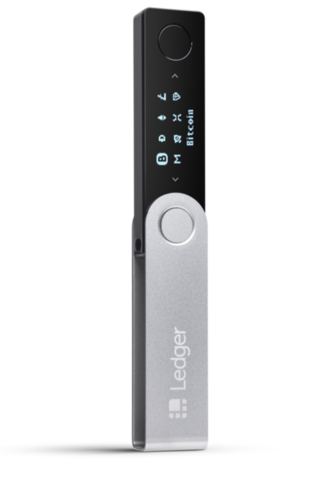
The Nano X is essentially an upgrade to the Nano S. It’s a powerhouse for storing all your digital assets. With two chips complementing each other and the innovation taking out USB connection and replacing it with Bluetooth, this wallet has a legitimate claim to being the best in the world save for its weak user interface. One noticeable difference with the Nano X is that it can hold multiple cryptocurrencies at once. With the Nano S, you have to uninstall old apps to make way for new ones.
Supported Coins:
Ledger supports a large variety of assets, including:
- Bitcoin
- Ethereum
- Ripple
- Tether
- Bitcoin Cash
- Litecoin
- And many more…
Ledger Nano X Price: $119
Pros
- The Nano X comes with Bluetooth functionality
- Users can add coins to the app directly
- It allows multiple coins and apps to function at the same time
Cons
- The user interface could be a bit technical for beginners
Ledger Nano S vs X
While the Ledger Nano S and X both support the same types of assets, they do have a few differences. For example, the X supports Bluetooth connection, a larger screen, and support for up to 100 applications at once as opposed to the three on the S.
The Ledger Nano X is also double the weight at 34 grams, with an 8-hour battery and USB-C connection as well. It’s certainly the better choice for users with a ton of crypto, while the S is better for newer holders without many assets.
3. Trezor One
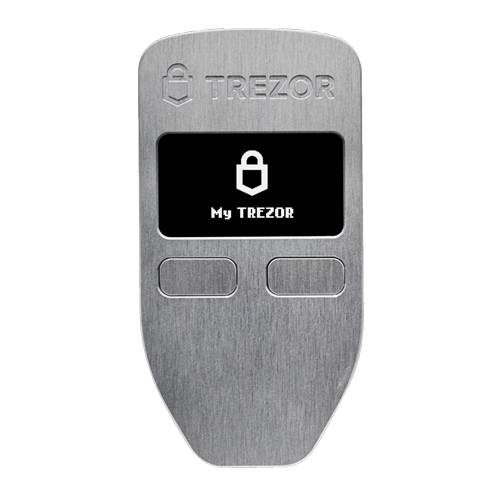
If there was ever a company to challenge Ledger’s supremacy in the hardware wallet market, it would be Trezor for sure. Both firms have been involved in a tit-for-tat for years now, trading filings and jabs at every turn.
SatoshiLabs built Trezor One, and it was the first secure and legitimate Bitcoin hardware wallet on the market. The wallets also bucked against the trend, looking more like calculators than the standard USB drive. The Trezor One only works with only the Android OS.
The Trezor One is perhaps Trezor’s flagship device. When connected to your laptop, you’ll need to enter a randomly-generated PIN. The number is generated randomly every time you connect. After the PIN, enter your passphrase, and you’re ready to transact. Trezor’s website shows that they support 1,064 coins. As expected, a lot of the popular picks are here.
While Ledger seems to focus on inclusiveness, security is Trezor’s biggest play. Wallets designed by the firm have PINs that remain even if their host computers are compromised. Trezor’s PINs also have in-built systems that prevent brute force attempts.
Also, after every incorrect attempt, the waiting time to log into a wallet is raised by a power of two. As expected, everyone gets a 24-word seed phrase when you set up. The Trezor One has had its run with scammers in the past but it’s still a great buy for anyone concerned about the security of their funds.
Supported Coins:
Trezor supports a large variety of assets, including:
- Bitcoin
- Ethereum
- Ripple
- Chainlink
- Bitcoin Cash
- Litecoin
- And many more…
Trezor One Price: $52
Pros
- Very simple to use
- Sleek design
- Useful on all platforms
- Greater security, thanks to a randomly-generated PIN
Cons
- Doesn’t support some notable assets such as Tezos, Ripple, Cardano, and Monero are absent
- It’s not a touch display. It works with buttons.
4. Trezor T
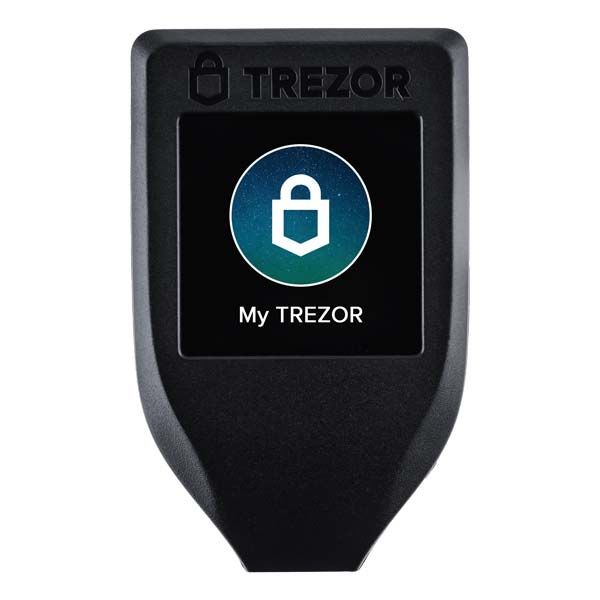
The Trezor T is to the Trezor One what the Nano X is to the Nano S. It comes with a larger screen, with a full touchscreen, so you get a smoother interface. To set this device up, you can connect to your phone or computer. Then, go to your browser and visit the manufacturer’s interface to begin setup. Choose the Model T option on the site, and follow the prompt.
If you’re backing up an old wallet, then click on the “create a backup in 3 mins” link. You’ll have to enter your 12-word recovery seed, although this time, you’ll simply need to input two random words from it.
Note that you’ll need to be careful with where you store the seed. If it falls into the wrong hands, they could import your wallet and make off with your money. In terms of coins support, it supports more coins than the Trezor One.
Supported Coins:
Trezor supports a large variety of assets, including:
- Bitcoin
- Ethereum
- Ripple
- Chainlink
- Bitcoin Cash
- Litecoin
- And many more…
Trezor T Price: $161
Pros
- Supports more coins
- Comes with a touchscreen
Cons
- It’s expensive
Trezor One vs. Trezor T
The two Trezor models differ much more than Ledger devices do.
For example, the Trezor One only has a monochrome display, security input via your computer or mobile device, and is missing microSD card support.
The Trezor T allows you to manage security on the device, offers a password manager on its microSD card, and an advanced form of authentication in FIDO2.
5. KeepKey
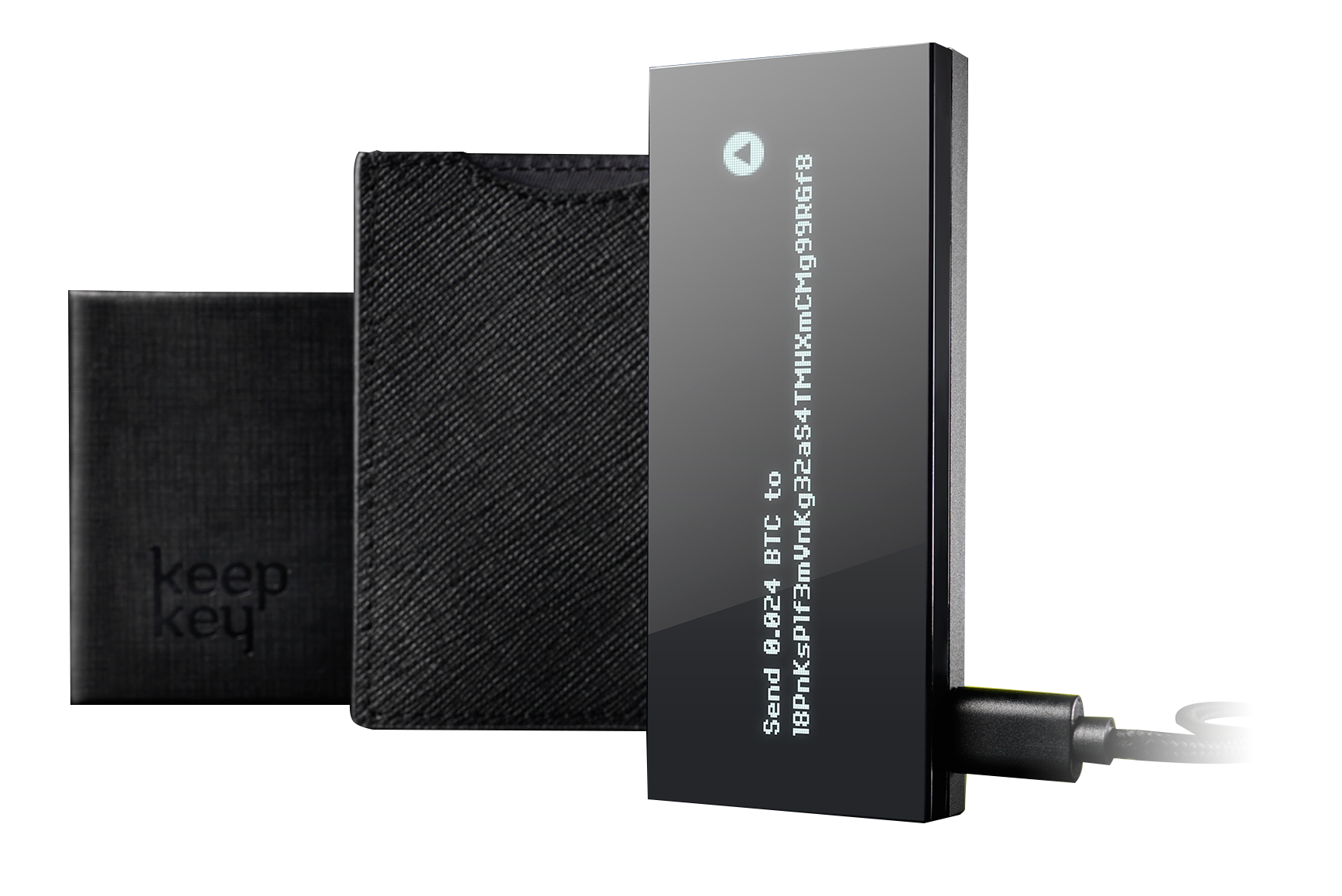
KeepKey was founded by Darin Stanchfield in 2015. The American company acquired a bitcoin custodian wallet called Multibit in 2016. A year later, it was acquired by Swiss cryptocurrency exchange ShapeShift.
The KeepKey wallet measures 8 x 93.5 x 12.2 mm. There’s a 256×64 3.12″ OLED screen at the front that’s protected by polycarbonate casing. There’s just one button up top, which works to cancel or confirm transactions. To get started with KeepKey, download and install its app from Google Chrome, and insert the wallet into your PC. Open the Chrome app, although you’ll need to update it if it’s not running on the latest firmware version.
If you’re running on the updated firmware, you will have access to the private key immediately. You’ll also see the seed phrase just once, after which you’ll need to commit it to memory or write it down. Make your PIN, and after confirming it, you get 12 randomly generated words to form your recovery sentence.
Note that KeepKey uses the “Recovery Cipher.” This system scrambles the letters of your chosen word, so even if the computer gets compromised, your wallet is safe.
In terms of supported coins, KeepKey is more limited than the others on this list. It only supports Bitcoin, Ether, Bitcoin Cash, Bitcoin Gold, Litecoin, DASH, and Dogecoin. It also supports ERC-20 tokens, but that’s a very limited count.
Supported Coins:
KeepKey supports a large variety of assets, including:
- Bitcoin
- Ethereum
- Bitcoin Cash
- Bitcoin Gold
- Litecoin
- DASH
- Dogecoin
- ERC-20 Tokens
KeepKey Price: $49
Pros
- Sturdy build with an interactive touchscreen
- Integrated with ShapeShift
- User-friendly design
- Heightened security, thanks to the recovery cipher
Cons
- You only get one chance to see the recovery seed
- A much more limited coin compatibility score
- Security laxity, as anyone can access the wallet without a PIN
6. CoolWallet S
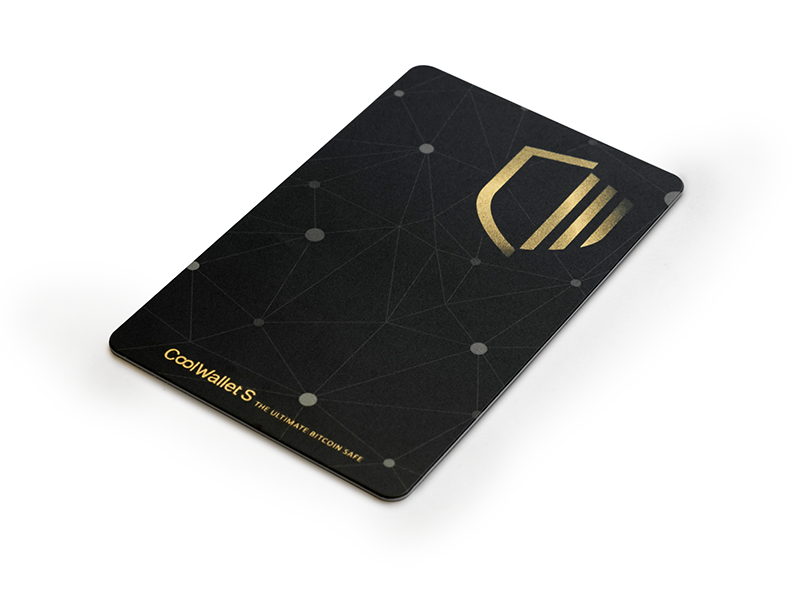
CoolWallet S was created by CoolBitX in 2015 as a hardware wallet that combines cold storage solutions. It provides a clean mix of security and portability, as it looks strikingly similar to a credit card.
This wallet is designed for investors on the move. You can send and receive Bitcoin, check your balances, and exchange cryptos using its Bluetooth-enabled, dual-device technology with the mobile app. The wallet has an e-paper display showing the Bluetooth indicator and the battery level. Setting up the wallet should take 20 minutes max but you need to download the CoolBitX app first on your mobile. Once that is completed, you’ll have to pair the wallet with your mobile device via Bluetooth before you’re allowed to create a wallet.
CoolWallet S supports over 20 cryptocurrencies, including all the large-cap favorites and all ERC-20 tokens.
Supported Coins:
CoolWallet supports a variety of assets, including:
- Bitcoin
- Ethereum
- Ripple
- Stellar
- Bitcoin Cash
- Litecoin
- ERC-20 Tokens
- And many more…
CoolWallet S price: $99
Pros
- Access to multiple wallets
- Exchange integration
- Secure AES-256 encryption
- Portable and durable build
- User-friendly operation
Cons
- Small screen
- Not open source
- You need the app to control most of the wallet’s features
Best Hardware Wallet Conclusion
Now that you’re aware of the different hardware wallets, here’s a chart summing up the devices, their prices, and their number of supported cryptocurrencies.
| Name | Price | Crypto Supported |
| Ledger Nano S | $55 | 1000+ |
| Ledger Nano X | $119 | 1000+ |
| Trezor One | $52 | 1000+ |
| Trezor T | $161 | 1000+ |
| Keepkey | $49 | 40+ |
| CoolWallet S | $99 | 20+ |
While storage can take various forms, it’s obvious that hardware wallets are the cream of the crop. They provide both optimal security and ease of use. It also gives the investor total control over their digital assets rather than entrusting it to a third-party like an exchange.
We recommend Ledger Nano X due to its wide coverage and Bluetooth integration. There’s also the fact that you can go through the entire recovery process without connecting to a computer. However, you should make sure you only get yours from the manufacturers directly.


